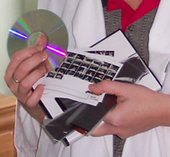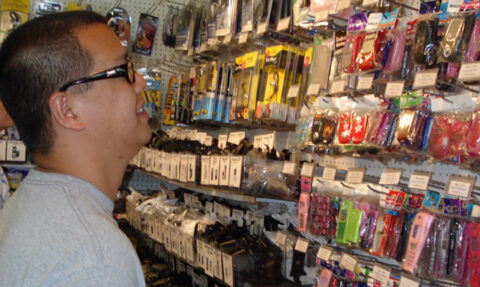Who knew?…
Here are a few things to keep in mind before you save something onto a CD or DVD.
 If you will be buying new CDs or DVDs soon… Or, if you plan to burn data, pictures, or music onto a CD or DVD in the near future… then check here first.
If you will be buying new CDs or DVDs soon… Or, if you plan to burn data, pictures, or music onto a CD or DVD in the near future… then check here first.
Following are some little-known tips for getting the most out of recordable discs, including:
- Writing on CDs & DVDs.
- Rewritable or Non-rewritable?
- Applying labels to discs.
- Assuring your data will stand the test of time.
- How to remove dust, dirt & scratches.
1. If you label your CDs and DVDs by writing directly on them, be sure to use a water-based pen because the alcohol found in other types of pens can seep into the dye on the disc and damage the data contained on that disc. However, Sharpie, for one, would dispute that.
2. You should always choose NON-rewritable (a.k.a. “write-once”) CDs and DVDs for archiving purposes. Why? Because they’re the least expensive, and the rewritable ones constantly change their state when you write to them… lowering the quality of the data that’s stored on them each time.
3. The spinning of a DVD (or CD) is a precise science. If you apply an adhesive label to your disc, always use a full-size circular label to maintain symmetry and balance on the disc. Also, use a label applicator to assure that the label will be centered and applied to the disc smoothly, with no air pockets.
DVDs are really 2 discs chemically bonded together, so you can’t put as much pressure on a DVD as you can on a CD when you take it in and out of its case. Such is why it is important to store DVDs in a case made for DVDs, rather than one made for CDs.
4. To prolong the life of your DVDs and CDs, be sure to protect them from intense light which will disturb the disc’s dye-layer and possibly make the data stored on that disc unreadable.
5. Extreme temperatures can affect the life of your CDs and DVDs. As a rule, discs should only be used (and stored) at temperatures within the ranges of 23 to 131 degrees Fahrenheit.
6. To remove dust, smudges, and minor scratches from DVDs and CDs, use a can of compressed air or “a wet disc cleanser” that’s intended for use with that particular type of media (CD or DVD).
For more detail about these CD and DVD tips — plus MANY more — check out Melissa Perenson’s column at PC Mag.
I got my first computer in 1986 and immediately started writing, saving documents, and organizing my entire life on it. Thus began my love affair with gadgets and all things tech. I built my first website in 1998 in old-school HTML code — before websites were "a thing". Blogs weren't invented yet. It was the same year that Google was born. My husband and I created TheFunTimesGuide.com in 2004 — before YouTube, Twitter, Reddit, and Mashable were launched. That was the year Facebook started and 'blog' was the Word of the Year according Merriam-Webster. Ever since then, anytime a new electronic gadget hits the market… I have to have it. (My husband's impulsive nature to try out every new tech gadget invented is even worse than mine!) When I'm not trying out fun new tech gadgets, you'll find me at the corner of Good News & Fun Times as publisher of The Fun Times Guide (32 fun & helpful websites).








